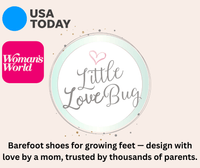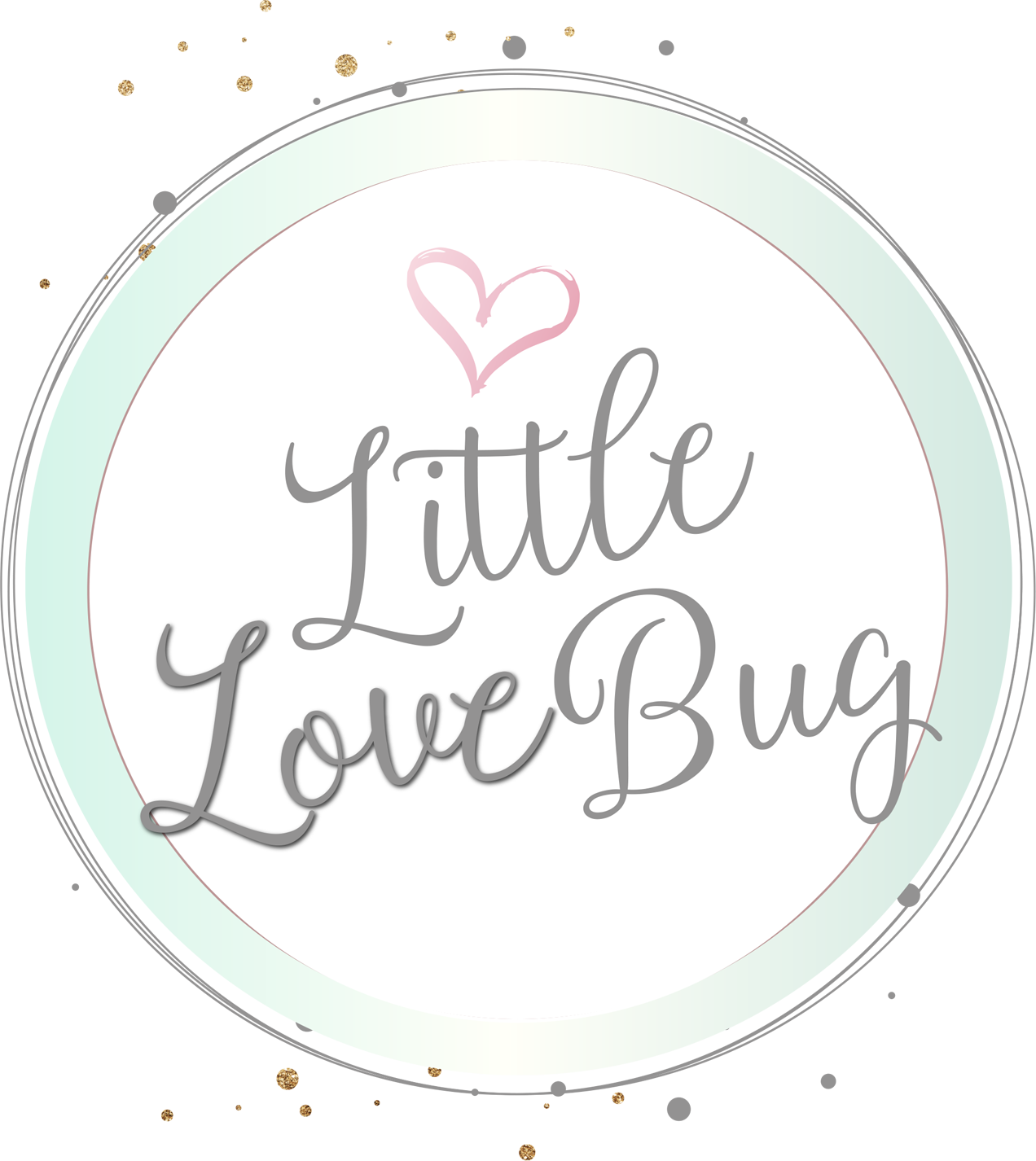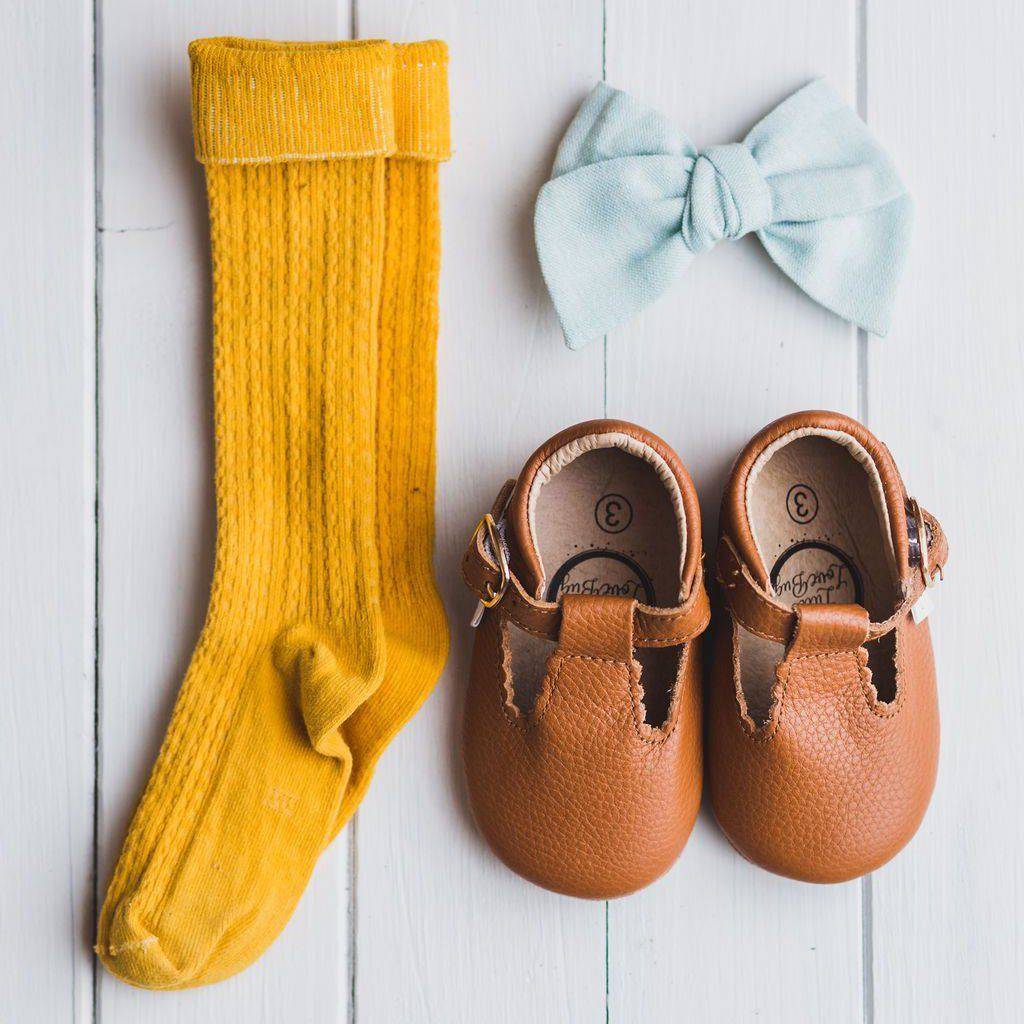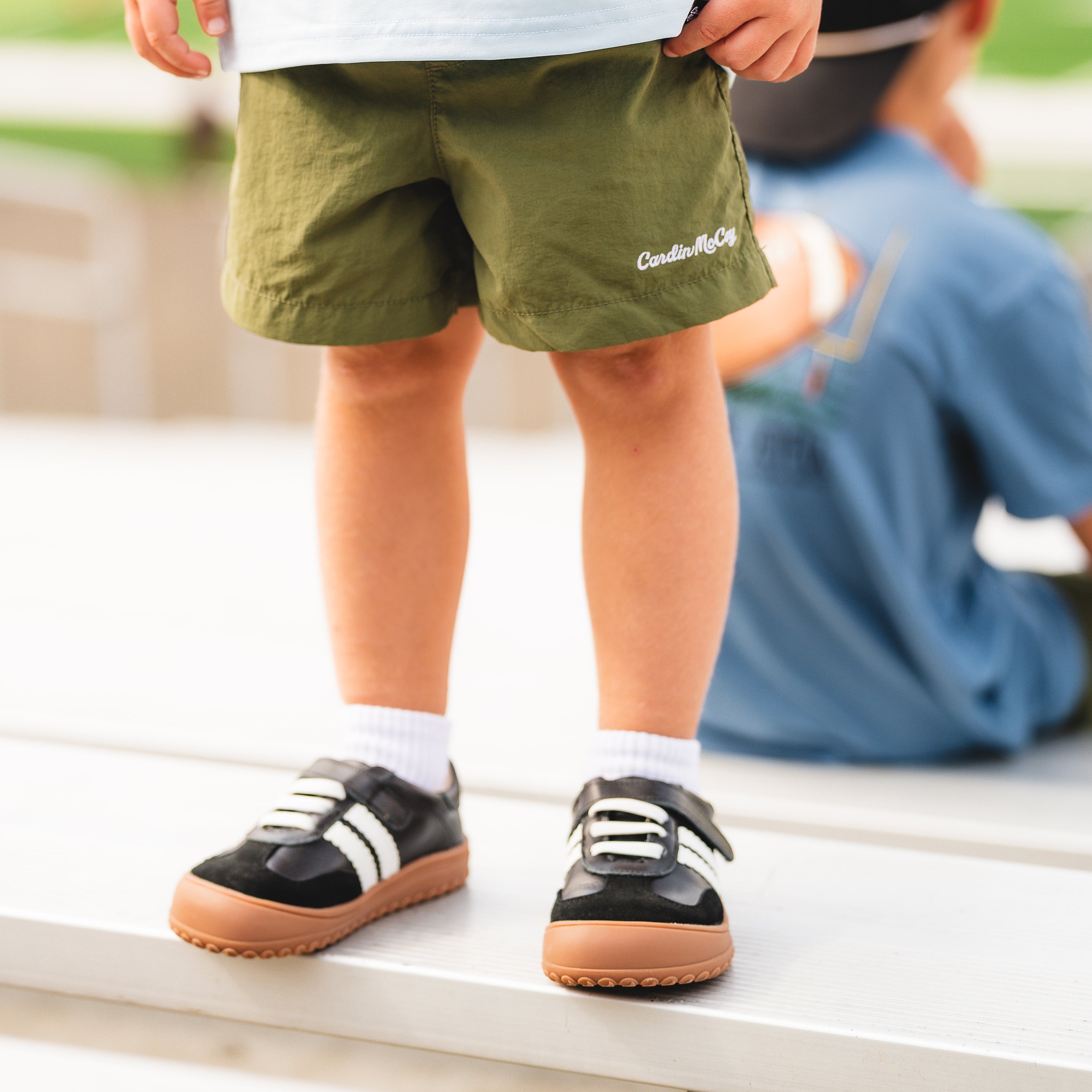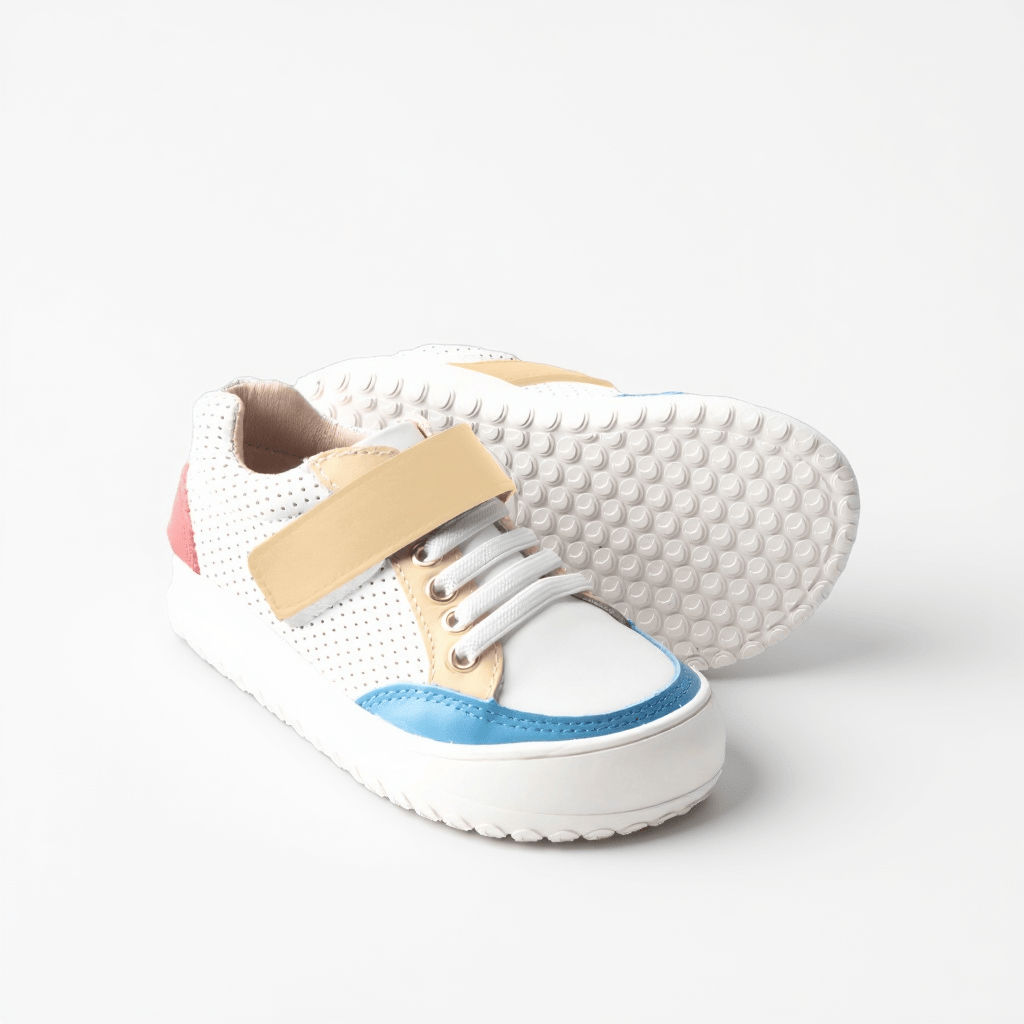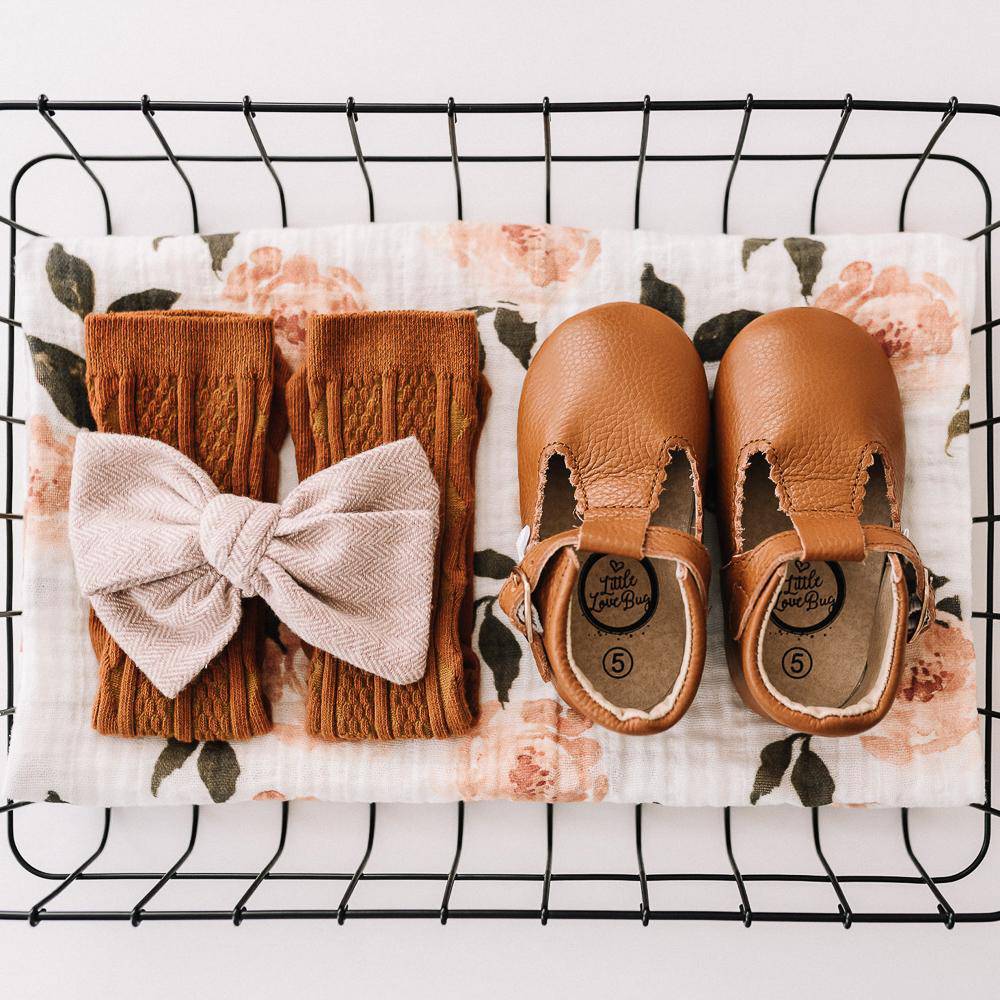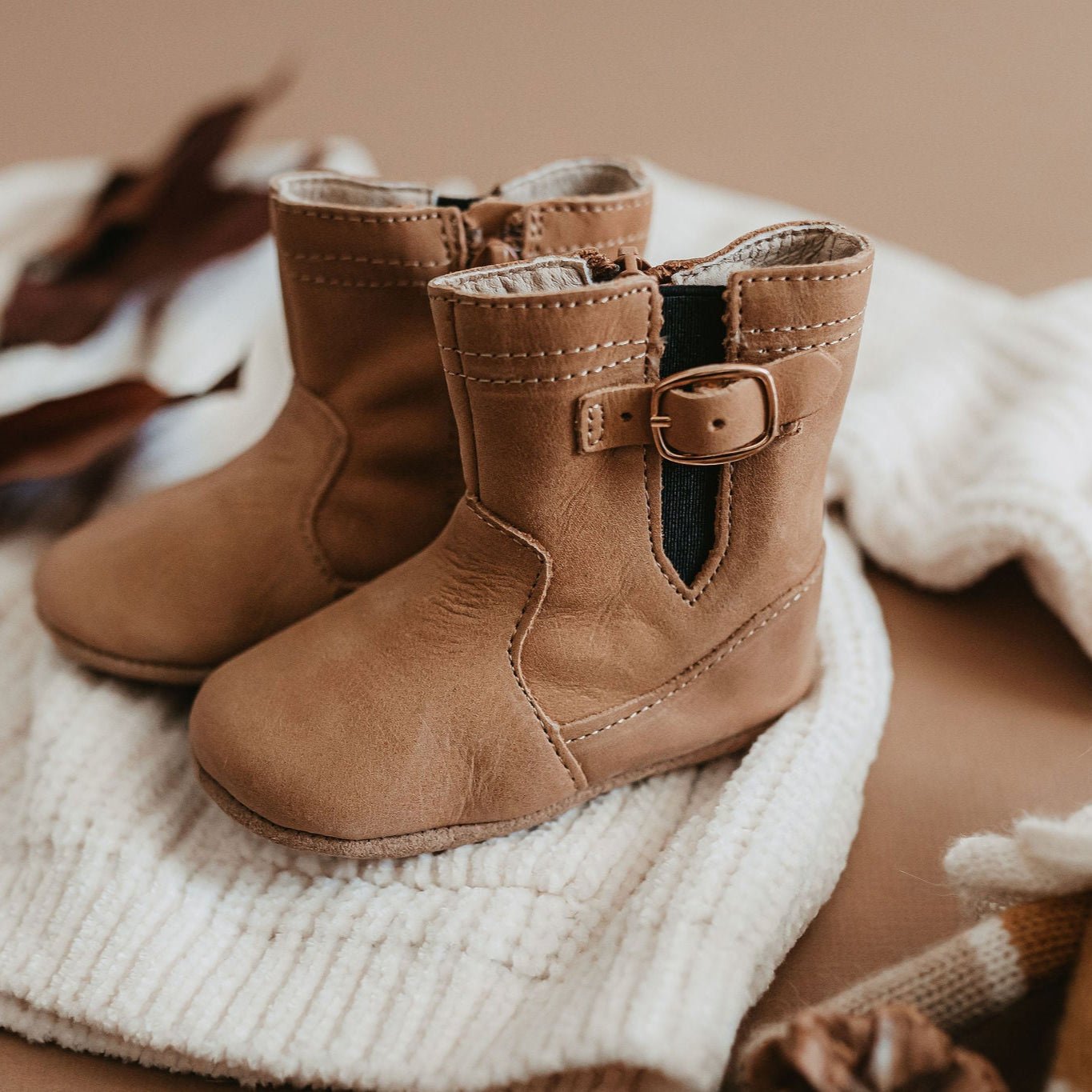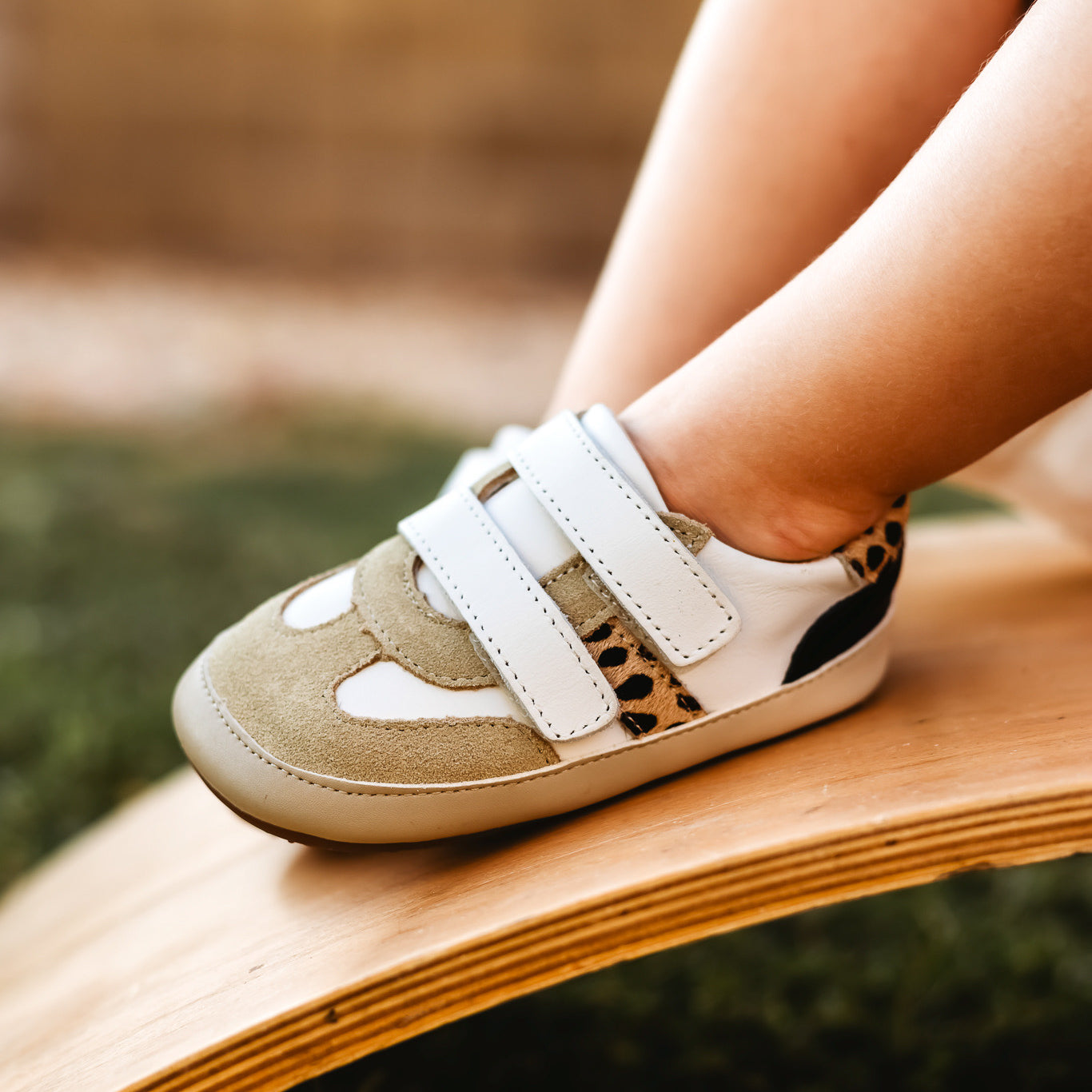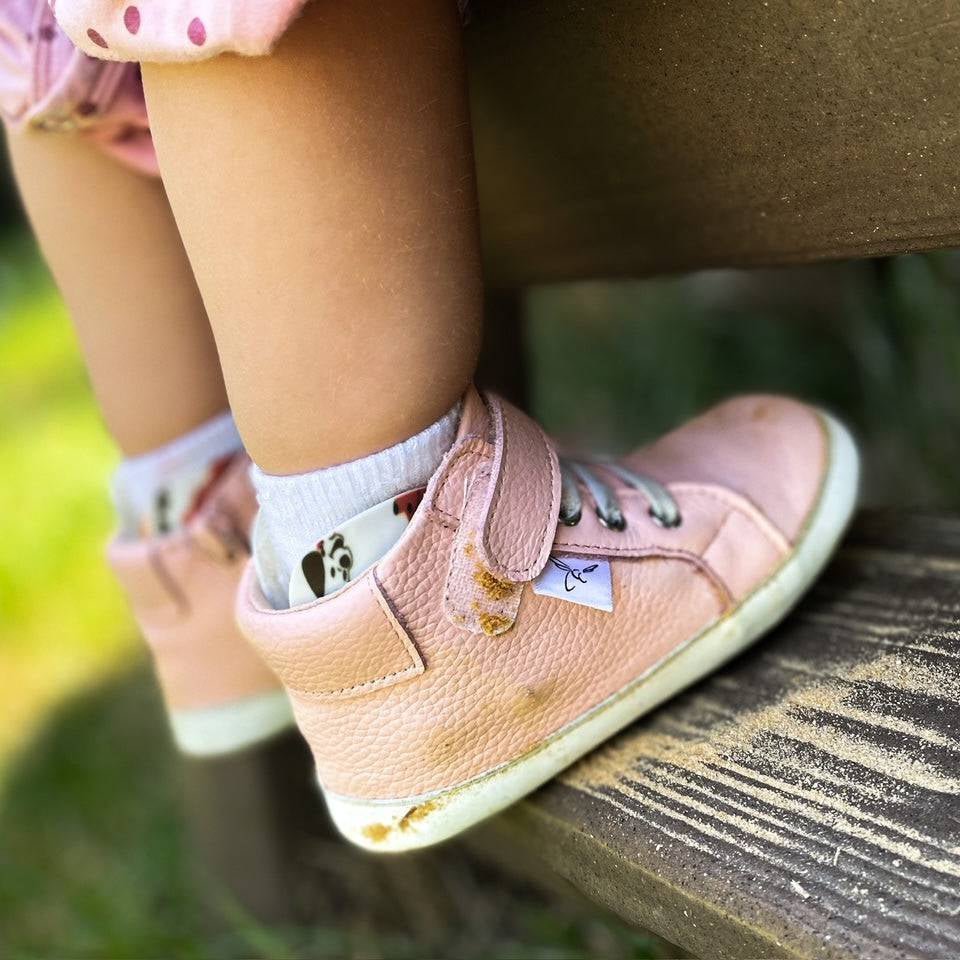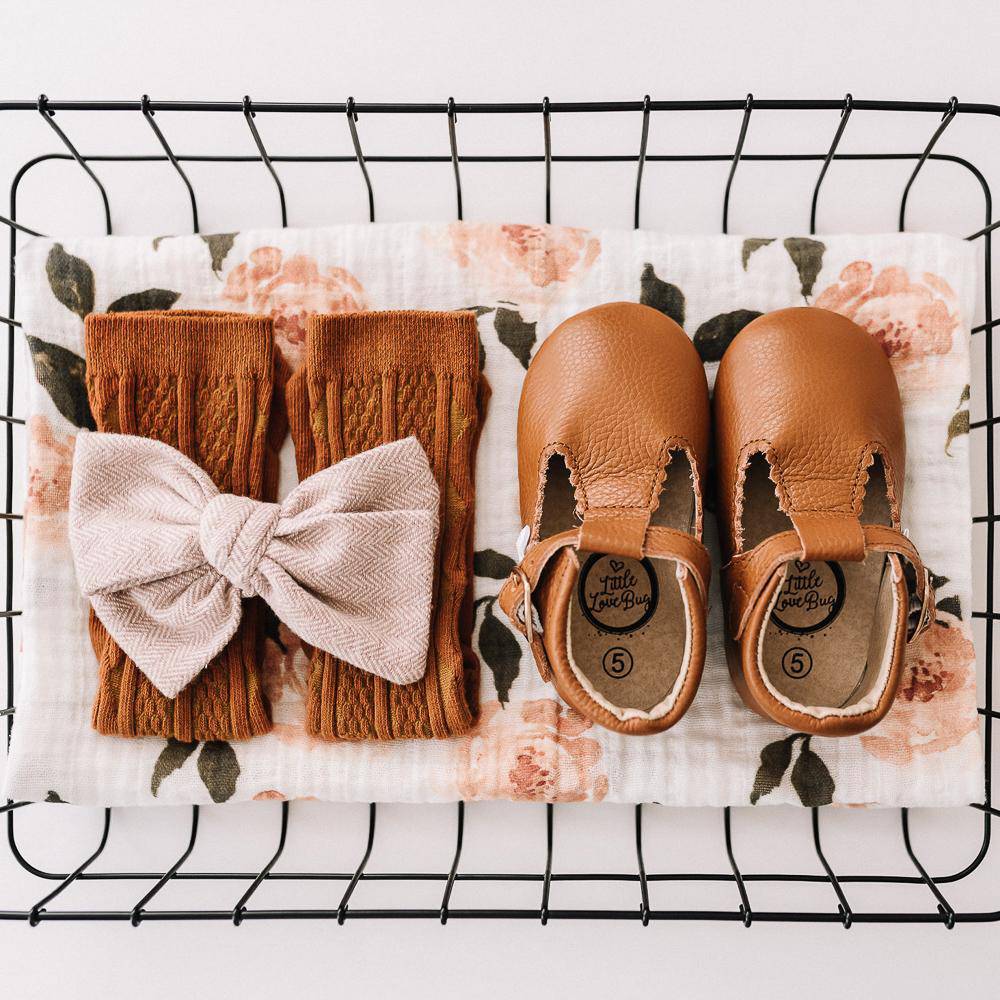News
Why Soft Sole Shoes?
It’s just silly! Because it’s such an easy problem to avoid, as 90% of children’s feet are born flawless – Let’s keep em that way by staying away from standard big box store shoes that are behind the times. It’s an easy fix! Just stop buying those old or nonscience based shoes…
Learn moreCaring for Your Baby's Fast-Growing Toenails: Preventing and Treating Ingrown Toenails
Babies' toenails exhibit astonishing growth rates, demanding special attention and care to avoid the discomfort associated with ingrown toenails. In this article, we explore the symptoms, causes, and effective home treatments for ingrown toenails in infants, along with essential tips to prevent their occurrence. Identifying Ingrown Toenails in Babies While ingrown toenails commonly manifest on the big toe, any toe can be susceptible to this issue. The toenail's edge grows into the skin, leading to redness, swelling, and potential discharge. Babies may express discomfort through crying, aversion to shoes, pulling at their toes, limping, or vocalizing distress. Understanding the Causes of Ingrown Toenails Several factors contribute to the development of ingrown toenails in babies. Prolonged nails, toenails curving down, stubbing toes, and wearing tight socks or shoes can all play a role in this painful condition. Home Treatment for Ingrown Toenails in Babies To alleviate pain and facilitate the release of ingrown toenails, regular soaking in lukewarm, soapy water is recommended. Gently massaging the nail fold after soaking helps the nail separate from the skin. Caution is advised against attempting to dig out or cut the nail, as it may increase infection risk. Instead, parents can consult with their healthcare provider regarding the use of antibiotic ointments and suitable pain management. During the treatment period, ensuring that the baby wears wide toe box shoes or goes barefoot enhances recovery. Improvement is typically noticeable within a few days of consistent care. When to Seek Professional Help If warm soaks do not yield improvement after two to three days, or if signs of infection appear, consulting a healthcare provider is essential. Severe cases may necessitate surgical intervention, making early detection crucial. Preventing Ingrown Toenails in Babies Proper nail care is paramount in preventing ingrown toenails. Using clean baby fingernail trimmers or a file, parents should trim toenails straight across, avoiding rounding at the edges. It's crucial not to trim them too short, leaving a small line of white nail at the tip. Regular monitoring of toenail growth, correct shoe size along with wide toe boxes, and avoiding tight socks contribute to overall preventive care.
Learn moreUncover the Truth about Modern Day Shoes!
👣 Uncover the Truth about Modern Day Shoes! 👣🚫 Foot Binding 2.0: The Hidden Problem 🚫 Did you know that modern day shoes affect your child's foot development? It's time to shed some light on this pressing issue! 🔍 The Reshaping Conundrum Our children's feet are designed to grow naturally, adapting to their unique shape and structure. However, the trendy footwear of today hinders this process. 😔👠 A Startling ComparisonBelieve it or not, there's a striking resemblance between modern shoe practices and the notorious foot binding traditions of the past! 😱 Just as foot binding distorted the natural shape of feet, contemporary shoes are reshaping our children's feet in ways that aren't too different. It's time to take a step back and rethink our approach. 🌱 Embrace Natural Foot FormEvery foot is beautiful and unique, just as nature intended. Let's allow our little ones to flourish by giving them the freedom to develop their feet naturally. 🌿💡 What Can We Do?1️⃣ Choose the Right Fit: Opt for shoes that provide ample space for your child's toes to wiggle and grow comfortably, as well as a flat, flexible sole so feet can FEEL the ground below them.2️⃣ Barefoot Moments: Encourage barefoot playtime whenever possible, allowing their feet to experience the ground and develop strength naturally.3️⃣ Seek Expert Advice: Consult with pediatricians or podiatrists to ensure your child's feet are developing properly. 📢 Spread Awareness!Share this post and raise awareness about the potential issues surrounding modern day shoes. Let's start a movement for healthier foot development among our children! Together, we can make a difference. ❤️#HealthyFeet #NaturalFootDevelopment #ChildrensHealth #FootAwareness #ReclaimingNaturalShape
Learn moreTop 1,000 Baby Girl Names in the U.S.
By Haley Jena With so many baby girl name options out there, choosing the right one can be a difficult decision. Here are the 1,000 top girl names in 2022 to help inspire you. IN THIS ARTICLE Top 1,000 most popular baby girl names How are the top baby girl names chosen? Baby girl names that are rising in popularity Baby girl names that were popular 100 years ago Most popular baby girl names by letter What's in a baby girl name? It can be challenging to choose the perfect name for your daughter but luckily, there's plenty of inspiration out there to help guide this important decision, whether you go for a classic, sweet girl name or a cool and unique moniker. A great place to start your baby name search is the Social Security Administration (SSA) Opens a new window, which releases a list of the 1,000 most popular baby names for girls and boys every year. The list below references SSA data from 2022. Top 1,000 most popular baby girl names Olivia Emma Charlotte Amelia Sophia Isabella Ava Mia Evelyn Luna Harper Camila Sofia Scarlett Elizabeth Eleanor Emily Chloe Mila Violet Penelope Gianna Aria Abigail Ella Avery Hazel Nora Layla Lily Aurora Nova Ellie Madison Grace Isla Willow Zoe Riley Stella Eliana Ivy Victoria Emilia Zoey Naomi Hannah Lucy Elena Lillian Maya Leah Paisley Addison Natalie Valentina Everly Delilah Leilani Madelyn Kinsley Ruby Sophie Alice Genesis Claire Audrey Sadie Aaliyah Josephine Autumn Brooklyn Quinn Kennedy Cora Savannah Caroline Athena Natalia Hailey Aubrey Emery Anna Iris Bella Eloise Skylar Jade Gabriella Ariana Maria Adeline Lydia Sarah Nevaeh Serenity Liliana Ayla Everleigh Raelynn Allison Madeline Vivian Maeve Lyla Samantha Rylee Eva Melody Clara Hadley Julia Piper Juniper Parker Brielle Eden Remi Josie Rose Arya Eliza Charlie Peyton Daisy Lucia Millie Margaret Freya Melanie Elliana Adalynn Alina Emersyn Sienna Mary Isabelle Alaia Esther Sloane Mackenzie Amara Ximena Sage Cecilia Valeria Reagan Valerie Catalina River Magnolia Kehlani Summer Ashley Andrea Isabel Oakley Olive Oaklynn Ember Kaylee Georgia Juliette Anastasia Genevieve Katherine Blakely Reese Amaya Emerson Brianna June Alani Lainey Arianna Rosalie Sara Jasmine Ruth Adalyn Ada Bailey Ariella Wren Myla Khloe Callie Elsie Alexandra Ryleigh Faith Norah Margot Zuri Journee Aspen Gemma Kylie Molly Blake Zara Alaina Alana Brynlee Amy Annie Saylor Ana Amira Kimberly Noelle Kamila Morgan Phoebe Harmony Sutton Taylor Finley Lilah Juliana Lila Londyn Kailani Vera Kaia Angela Hallie Diana Lennon Presley Arabella Aliyah Lilly Milani Jordyn Camille Ariel Aubree Selena Sawyer Nyla Delaney Mariana Rachel Adaline Leila Collins Lia Octavia Kali Lena Kiara Kaylani Elaina Daniela Leia Gracie Dakota Elise Hope Harlow Lola Stevie Malia Miriam Alora Gia Evangeline Brooke Lilith Sydney Ophelia Alayna Tatum Evie Rowan Marley Daphne Kayla Dahlia Lucille Blair Adelaide Wrenley Haven Teagan Adelyn Alyssa Payton Jane Mckenna Celeste Juliet Palmer Maggie Rebecca London Noa Samara Thea Kendall Mya Talia Winter Angelina Vivienne Esme Laila Nina Trinity Vanessa Mabel Camilla Jocelyn Journey Paige Phoenix Amina Alivia Amari Joanna Nicole Annabelle Raegan Aitana Julianna Lauren Catherine Adriana Madilyn Harley Tessa Evelynn Elianna Rory Dream Nayeli Poppy Gabriela Jayla Cataleya Celine Hayden Shiloh Mariah Charlee Maisie Regina Adelynn Briella Giselle Fatima Danna Alessia Mckenzie Wynter Fiona Brooklynn Gracelynn Luciana Alexis Everlee Laura Selah Reign Alayah Rosemary Lilliana Ariyah Heidi Esmeralda Logan Amora Kalani Leighton Cali Melissa Aniyah Izabella Michelle Raelyn Alessandra Viviana Madeleine Arielle Serena Francesca Brynn Gwendolyn Kira Destiny Elle Makayla Alaya Malani Willa Saige Makenna Remington Demi Adelina Raya Astrid Azalea Veronica Meadow Anaya Elisa Raven Alexandria Hattie Alicia Sabrina Gracelyn Matilda Skye Annalise Frances Miracle Maia Helen Lana Daleyza Rosie Charli Bianca Royalty Sarai Amiyah Nylah Aylin Maryam Scarlet Antonella Sylvia Sylvie Nadia Ari Lexi Mylah Julieta Lorelei Avianna Armani Camryn Emely Rylie Colette Daniella Liana Brinley Kate Salem Marlee Alison Carmen Felicity Fernanda Holly Ariah Aisha Kora Amanda Ailani Elaine Emory Joy Oaklee Lyric Madelynn Haisley Allie Helena Danielle Katalina Carolina Zariah Navy Cassidy Lorelai Stephanie Alma Mira Legacy Jolene Anya Dorothy Paris Yaretzi Aurelia Maddison Renata Jimena Xiomara Itzel Heaven Lyra Estella Gabrielle Maren Jacqueline Jennifer Imani Jordan Paislee Ainsley Emmy Jessica Alondra Mae Makenzie Bristol Edith Cameron Elora Jazlyn Averie Ivory Kenzie Emelia Angel Cecelia Maliyah Oakleigh Opal Oaklyn Kinley Kayleigh Bonnie April Kamryn Mallory Briar Leona Keira Alexa Macie Ariya Briana Virginia Skyler Amber Hanna Monroe Frankie Miranda Dayana Charleigh Meredith Carter Sierra Sunny Indie Eve Beatrice Nalani Kyla Clementine Katie Kennedi Myra Blaire Davina Faye Anahi Madilynn Alejandra Alanna Ivanna Mariam Yara Anne Addilyn Braelynn Lilian Dylan Amirah Lina Reyna Amalia Amani Ryan Calliope Isabela Michaela Abby Alia Emerie Lylah Holland Sevyn Winnie Leyla Shelby Rosalia Zariyah Rhea Emberly Marie Nia Remy Chaya Haley Kaliyah Rosa Zahra Jayleen Karsyn Malaysia Jaliyah Mina Kensley Lennox Maxine Hadassah Mikayla Margo Noah Azariah Mara Eileen Florence Melany Reina Journi Amaia Kaitlyn Elliott Kelsey Nola Gloria Keilani Freyja Arleth Jenna Sloan Analia Louise Melina Sasha Dior Thalia Noemi Maci Dallas Marina Aliana Ezra Adley Cassandra Aleena Leslie Capri Mckinley Angelica Romina Della Kathryn Kyra Milan Tiana Khaleesi Nellie Cleo Murphy Bethany Irene Ellianna Zelda Aleah Janelle Yareli Adalee Dani Marceline Coraline Estrella Ila Iyla Mavis Kenna Vienna Zendaya Cheyenne Erin Karla Mikaela Jazmin Persephone Elodie Selene Chelsea Scout Theodora Lara Marilyn Novah Ellis Charley Jemma Amayah Karina Kendra Miley Laney Laurel Leilany Halle Jenesis Malaya Marleigh Wrenlee Zaylee Fallon Julie Priscilla Bellamy Adrianna Angie Siena Aileen Macy Estelle Hana Martha Flora Kylee Liv Megan Sariyah Galilea Penny Jovie Jamie Amoura Emmie Henley Sky Christina Violeta Arlet Belen Aviana Kori Monica Savanna Naya Alena Aya Waverly Brynleigh Aliza Kiana Love Clover Pearl Skyla Bria Ocean Alisson Treasure Lillie Jaylani Liberty Rayna Milana Zaria Emerald Halo Taytum Andi Milena Noor Kataleya Kimber Carly Jream Samira Ashlyn Hunter Marlowe Promise Joelle Dulce Lea Ashlynn Zoya Elliot Jolie Kai Bridget Johanna Paulina Ramona Aila Jessie Mercy Rayne Rivka Arlette Paula Valery Birdie Nala Kelly Kinslee Linda Madisyn Aspyn Baylor Chana Zaniyah Goldie Marianna Novalee Loretta Elyse Stormi Adele Berkley Anika Marisol Kassidy Roselyn Louisa Alexia Dalia Ensley Hayley Jayda Harmoni Jada Marigold Zayla Ayleen Natasha Sol Annika Malayah Drew Anais Angelique Zhuri Aliya Azaria Zora Allyson Brittany Kamiyah Gwen Vada Giuliana Elina Hadlee Itzayana Jianna Cadence Greta Lilianna Denver Robin August Jazmine Royal Braelyn Celia Yamileth Avayah Baylee Iliana Teresa Amelie Judith Kara Lacey Amiri Elowyn Georgina Justice Emmalyn Harlee Kamari Kaydence Khalani Luisa Whitley Bailee Cynthia Karter Livia Aubrie Veda Janiyah Salma Araya Aubrielle Bexley Giana Keyla Katelyn Saoirse Sariah Araceli Artemis Averi Yasmin Kaiya Emberlynn Amaris Sapphire Kallie Shay Guinevere Lilyana Magdalena Tinsley Zainab Deborah Kenia Laylah Layne Scottie Carla Chandler Rosalina Kairi Lauryn Nyomi Raina Aubriella Elia Lenora Lisa Nori Tiffany Giovanna Jaylah Rosalyn Chanel Maddie Avah Leanna Luz Addilynn Brylee Casey Laylani Tru Billie Lottie Alianna Meilani Lexie Nathalia Avalynn Julissa Paloma Rosalee Rebekah Simone Egypt Scarlette Sarahi Alaiya Hadleigh Inaya Keily Lakelynn Nyra Princess Rowyn Vida Elisabeth India Ryann Barbara Belle Saanvi Xyla Winona Aadhya Indigo Lakelyn Paola Emmeline Joyce Kamilah Maisy Rylan Soleil Ainhoa Maleah Neriah Elsa Emiliana Luella Nancy Cielo Madalyn Kahlani Here, browse the top 1,000 baby girl names for inspiration (or to see if your little one's name made the list!).
Learn moreChoosing the Best Shoes for Developing Feet: The Benefits of Barefoot-Style Footwear
Choosing the Best Shoes for Developing Feet: The Benefits of Barefoot-Style FootwearWhen it comes to the optimal development of children's feet, it's important to consider the shoes they wear. Traditional shoes with rigid soles and excessive cushioning may hinder the natural movement and growth of their feet. Barefoot-style shoes, on the other hand, offer several benefits by promoting a more natural and unrestricted foot development. In this article, we will explore the advantages of barefoot-style footwear and highlight the best styles to consider for your child's developing feet.The Benefits of Barefoot-Style Shoes:1. Enhances Natural Foot Function: Barefoot-style shoes allow the foot to move and flex more freely, mimicking the sensation of being barefoot. This promotes better muscle strength, joint mobility, and balance, as the foot can engage its natural range of motion.2. Encourages Proper Foot Alignment: Shoes with minimal structure and heel elevation promote a more neutral foot alignment. This can help prevent issues like overpronation or supination, leading to improved walking and running mechanics.3. Stimulates Sensory Feedback: Barefoot-style shoes provide a closer connection between the feet and the ground, allowing children to better sense and respond to various surfaces. This sensory feedback helps develop proprioception (awareness of body position) and contributes to better overall stability.4. Supports Natural Arch Development: Traditional shoes with arch supports can interfere with the natural development of the foot's arches. Barefoot-style shoes promote intrinsic muscle strength, allowing the arches to develop and support the foot more effectively. Best Styles of Barefoot-Style Shoes:1. Minimalist Sneakers: Look for sneakers with flexible soles, wide toe boxes, and thin yet durable materials. They should provide ample space for the toes to spread naturally and allow for unrestricted movement.2. Soft-Soled Shoes: Soft-soled shoes, often made of breathable and flexible materials like leather or fabric, are a great choice for infants and early walkers. They provide protection while allowing the foot to move naturally.3. Barefoot Sandals: Designed to mimic the feeling of being barefoot, these sandals offer minimal coverage with thin, flexible soles. They allow for ample ventilation and freedom of movement during warm weather.4. Moccasins: Made from soft, pliable materials, moccasins provide a flexible and lightweight option for toddlers and young children. They allow the foot to flex and provide a closer-to-barefoot experience.5. Water Shoes: Water shoes with thin, flexible soles are excellent for outdoor activities and water play. They provide protection while allowing for natural foot movement and drainage.6. Toe-Separated Shoes: Toe-separated or "toe shoes" offer individual compartments for each toe, allowing for optimal toe splay and improved balance. These shoes promote toe strength and flexibility.Choosing the right shoes for your child's developing feet is crucial for their overall foot health and proper growth. Barefoot-style footwear offers numerous benefits by supporting natural foot function, alignment, and sensory development. When selecting barefoot-style shoes, prioritize flexible soles, wide toe boxes, and lightweight materials. Remember, allowing children to spend time barefoot whenever appropriate is also beneficial. By prioritizing the well-being of your child's feet and embracing the freedom and flexibility of barefoot-style shoes, you can contribute to their healthy foot development and help them navigate the world with confidence.
Learn moreIdentifying Common Foot Deformities in Babies: When to Seek Medical Attention
Identifying Common Foot Deformities in Babies: When to Seek Medical AttentionIntroduction:As parents, we closely monitor our babies' growth and development, including the health and appearance of their tiny feet. While most infants are born with perfectly formed feet, it's essential to be aware of common foot deformities that can occur. Recognizing these conditions early on can help ensure timely intervention and prevent potential complications. In this article, we will discuss some of the top foot deformities in babies, what to look for, and when it's crucial to seek medical advice.Clubfoot:Clubfoot, or talipes equinovarus, is a common foot deformity where the foot turns inward and downward. Signs of clubfoot include the foot's abnormal positioning, such as being rotated inward, with the sole facing sideways or even upward. The affected foot may also appear smaller and have a higher arch. If you notice these symptoms, it's essential to contact your doctor promptly for further evaluation and guidance.Metatarsus Adductus:Metatarsus adductus is a condition characterized by a curved or turned-in shape of the front part of the foot. The affected foot may have a "C" or "S" shape, with the inner edge of the foot curving inward. It can be flexible or rigid. While mild cases of metatarsus adductus often resolve on their own, severe or rigid cases may require intervention. Consult your healthcare provider if you observe persistent or worsening symptoms.Flat Feet:Flat feet, also known as pes planus, is a condition where the arch of the foot appears flattened or absent. In infants, it's common for the arches to appear flat due to fat pads in the feet. However, if the flatness persists beyond the age of three or is associated with pain, stiffness, or difficulty walking, medical attention should be sought.Toe Abnormalities:Toe abnormalities can include conditions such as overlapping toes, webbed toes, or extra toes (polydactyly). While some toe variations are harmless and do not require treatment, others may require medical intervention. If you notice significant deformities, restricted movement, or any concerns related to your baby's toes, consult your doctor for a proper assessment.When to Contact a Doctor:It's important to reach out to your healthcare provider if you observe any of the following concerning signs:1. Severe or worsening deformities: If the foot deformity appears to be significant, progressive, or causing discomfort to your baby, seek immediate medical attention.2. Difficulty with weight-bearing or walking: If your baby is not able to put weight on the affected foot or is experiencing difficulty walking, it's crucial to consult a doctor for a comprehensive evaluation.3. Asymmetry or one-sided deformity: If you notice that one foot appears noticeably different from the other or if the deformity is present only on one side, it's recommended to seek medical advice to rule out underlying conditions.4. Lack of improvement over time: If you've been monitoring a foot deformity and it hasn't shown signs of improvement or appears to be worsening, it's important to have your baby assessed by a healthcare professional.Remember, early detection and intervention play a significant role in managing foot deformities in babies. Your healthcare provider can provide a proper diagnosis, determine the best course of action, and refer you to a specialist if necessary. Trust your instincts as a parent, and never hesitate to seek medical advice when you have concerns about your baby's foot health.
Learn moreDealing with Ingrown Toenails in Babies: Causes, Symptoms, and Treatment
Dealing with Ingrown Toenails in Babies: Causes, Symptoms, and TreatmentIntroduction:Ingrown toenails can be a painful condition that affects people of all ages, including infants and babies. Although it is more commonly associated with adults, ingrown toenails in babies can occur due to various reasons. In this article, we will explore what ingrown toenails look like in babies, discuss the symptoms to expect, and provide insights into how to effectively manage and treat this condition.What do ingrown toenails in babies look like?When a baby has an ingrown toenail, you may notice the following characteristics:1. Redness and swelling around the affected toenail: The surrounding skin may appear inflamed and tender.2. Pain and discomfort: Babies may exhibit signs of discomfort, such as fussiness or reluctance to put weight on the affected foot.3. Changes in nail appearance: The toenail might appear curved, growing into the surrounding skin instead of straight out.What to expect when your baby has an ingrown toenail?If your baby is suffering from an ingrown toenail, you can anticipate the following symptoms:1. Irritability and fussiness: The discomfort caused by the ingrown toenail may lead to increased irritability in your baby.2. Difficulty walking or crawling: Babies with ingrown toenails may find it uncomfortable to put pressure on the affected foot, leading to changes in their mobility.3. Risk of infection: Ingrown toenails create an ideal environment for bacterial infection. If left untreated, you may observe signs of infection, including increased redness, pus formation, and a foul odor.How to get rid of ingrown toenails in babies:Managing and treating ingrown toenails in babies requires gentle care and attention. Here are some steps you can take:1. Consult a healthcare professional: If you suspect your baby has an ingrown toenail, it is important to seek medical advice. A pediatrician or a podiatrist can examine the condition and provide appropriate guidance.2. Warm water soak: Soaking your baby's foot in warm water for 10 to 15 minutes, a few times a day, can help reduce swelling and relieve discomfort. Make sure the water is comfortably warm and not too hot.3. Gentle nail care: After soaking, use a clean, soft cloth to carefully push the skin away from the ingrown nail edge. Avoid cutting the nail yourself, as this may cause further injury or infection.4. Proper footwear: Ensure your baby wears loose-fitting, comfortable shoes or socks that do not put pressure on the affected toe. This allows the toe to heal and prevents further irritation.5. Antibiotic ointment and bandage: If an infection is present or suspected, your healthcare professional may recommend applying a topical antibiotic ointment and covering the area with a sterile bandage.6. Follow professional advice: Your healthcare provider may suggest specific treatments based on the severity of the condition. They may suggest using a toenail brace, prescribing antibiotics, or, in rare cases, performing a minor surgical procedure to remove the ingrown portion of the nail.Prevention tips:To help prevent ingrown toenails in babies, consider the following precautions:1. Trim toenails carefully: When trimming your baby's nails, ensure you cut them straight across without rounding the corners. This helps prevent the nails from growing into the skin.2. Choose proper footwear: Make sure your baby's shoes or socks are not too tight, allowing room for the toes to move freely.3. Maintain good foot hygiene: Regularly clean your baby's feet, ensuring they are dry after bathing. Proper hygiene reduces the risk of bacterial growth and infection.Conclusion:Ingrown toenails can be uncomfortable and painful, even for babies. It's essential for parents and caregivers to be vigilant and address this condition promptly to ensure their baby's comfort and prevent potential complications. By seeking medical advice, practicing gentle nail care, providing proper footwear, and following professional recommendations, you can effectively manage and treat ingrown toenails in babies. Remember, prevention is key, so practicing good foot hygiene and being cautious while trimming your baby's nails can help reduce the risk of ingrown toenails. By taking these steps, you can ensure your baby's little feet stay healthy and free from the discomfort of ingrown toenails.
Learn moreHolistic Ways to Keep Your Kids Healthy and What to Do If They've Gotten Sick
Holistic Ways to Keep Your Kids Healthy and What to Do If They've Gotten SickIntroduction:Keeping your children healthy is a top priority for parents. While traditional medicine plays a crucial role in treating and preventing illnesses, holistic approaches can complement medical interventions and promote overall well-being. By focusing on a holistic lifestyle, you can empower your children to lead healthier lives and effectively address health issues when they arise. In this article, we will explore holistic ways to keep your kids healthy and provide guidance on what to do if they fall ill.1. Balanced Nutrition:Proper nutrition forms the foundation of good health. Ensure your child's diet is rich in fruits, vegetables, whole grains, and lean proteins. Limit processed foods, refined sugars, and unhealthy fats. Encourage regular mealtimes and involve your children in meal planning and preparation to promote their interest in nutritious foods.2. Regular Physical Activity:Encourage your children to engage in regular physical activity to strengthen their bodies and boost their immune systems. Encourage outdoor play, sports, dance, yoga, or martial arts. Limit screen time and sedentary activities, fostering a love for movement and exercise.3. Adequate Sleep:Restful sleep is vital for children's growth, development, and immune function. Establish a consistent bedtime routine and ensure your child gets the recommended hours of sleep for their age group. Create a peaceful sleep environment by limiting electronic devices in the bedroom and promoting relaxation techniques such as reading or listening to calming music.4. Emotional Well-being:A healthy mind is closely linked to physical well-being. Encourage open communication with your children and create a supportive and nurturing environment. Teach them mindfulness techniques and stress management skills to cope with everyday challenges. Engage in activities such as storytelling, art, or music to promote emotional expression and creativity.5. Natural Remedies:Holistic approaches often involve the use of natural remedies to support your child's health. For minor ailments like coughs, colds, or mild digestive issues, consider herbal teas, honey, ginger, or chamomile. Always consult with a healthcare professional before using any natural remedies, especially if your child has pre-existing conditions or takes medication.What to Do If Your Child Gets Sick:Despite your best efforts, children may still fall ill. Here's what you can do:1. Stay Calm and Observe: Pay attention to your child's symptoms and monitor their condition closely. Note any changes in behavior, appetite, or sleep patterns.2. Seek Medical Advice: Consult a healthcare professional for an accurate diagnosis and appropriate treatment. They can provide guidance on whether to treat the illness at home or visit a healthcare facility.3. Provide Comfort and Hydration: Offer your child plenty of fluids to prevent dehydration. Use warm compresses, humidifiers, or saline nasal drops to alleviate congestion or discomfort.4. Follow Prescribed Treatments: If your child is prescribed medication, ensure they take it as directed. Maintain a proper schedule and complete the course of treatment to maximize its effectiveness.5. Maintain a Healing Environment: Create a soothing environment at home to aid your child's recovery. Offer healthy, easily digestible meals, maintain good hygiene, and provide ample rest and relaxation.Conclusion:By embracing a holistic approach to your children's health, you can foster their overall well-being and support their immune systems. Balanced nutrition, regular physical activity, adequate sleep, emotional well-being, and natural remedies can complement traditional medical interventions. If your child falls ill, it's essential to seek medical advice, provide comfort, and maintain a healing environment. By combining holistic and conventional approaches, you can optimize your child's health and well-being throughout their lives.
Learn moreDiscover the Secret to Stronger, Healthier Feet with Barefoot Shoes!
When people hear that I wear barefoot shoes, their first question is often, "Do you wear those dorky shoes with individual toes?" Let me clarify, no, I don't wear toe shoes, and neither do you or your little one need them for healthy feet. I can personally attest to the fact that I feel my feet getting stronger wearing barefoot shoes. It's an unusual sensation. And I understand why kids who have worn barefoot shoes also have overwhelmingly positive feedback, preferring the lighter and more comfortable option over traditional structured lace-up school shoes or sneakers. Extensive studies on modern-day (standard) shoes have revealed that wearing them from an early age can cause more problems than not wearing them at all. Issues like deformation from ill-fitting shoes, ingrown toenails, and athlete's foot have been linked to early shoe usage. So why is this? Research published in The Foot, a podiatry journal, in 2007, suggests that forcing the foot to conform to the shape and constraints of a shoe can lead to structural and functional changes, particularly in young children whose feet are more vulnerable to damage. That's why I created Little Love Bug in 2017—to provide a solution that combines both style and ergonomics. When it comes to children's footwear, it's essential to remember that their feet are not miniature versions of adult feet. At birth, their feet consist of cartilage and gradually develop into the 28 bones of the adult foot over time. This process continues until the late teenage years, emphasizing the importance of choosing suitable footwear during this crucial period. There's an abundance of research supporting the growing trend and benefits of barefoot shoes, questioning the necessity of highly cushioned and supportive footwear for both children and adults. The remarkable results of wearing barefoot shoes include increased foot strength, balance, mobility, and ankle function—benefits typically associated with walking barefoot. Little Love Bugs reinforce the natural running technique that children are born with—forefoot striking rather than heel striking. Toddlers instinctively adopt this technique when running. It's only when we switch to thick-soled and heavier shoes that we retrain ourselves to run differently, potentially leading to knee, hip, and lower back pain associated with heel striking. So release the toes! And let your little run the way nature intended… With Little Love Bugs.
Learn more